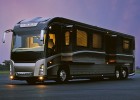The U.S. Army booth at the 2011 Chicago Auto Show will highlight two hybrid powered combat vehicles that offer both fuel economy and stealth.
The Quantum Technologies Clandestine Extended Range Vehicle (CERV) and the Future Tactical Truck System (FTTS) represent the Army initiative to provide next generation Joint Light Tactical Vehicles and high performance light duty off-road hybrid trucks.
The CERV’s target mission, according to Quantum, “would be related to special operations-type missions involving reconnaissance, surveillance, targeting, search and rescue and assist with field rescue operations.”
Features of the CERV include the 2nd generation advanced all-wheel-drive diesel hybrid electrical power-train that produces 5,000 foot-pounds of torque. With hybrid technology, designers say the vehicle reduces fuel consumption by 25 percent thus reducing the number of resupply vehicles needed during military operations.
It has the capacity to carry three soldiers with gear, boasts a 600-mile driving range utilizing the external fuel tanks, incorporates a polycarbonate windshield and includes an onboard electrical winch capable of pulling 10,000 lbs. The CERV has a top speed of 80 miles-an-hour, can climb up to 60 percent grades, has the capacity to forge water up to 21 inches deep, has a turning capacity of 30 feet and has a maximum towing capacity of up to 5,000 lbs.
The FTTS was designed, according to engineers, to replace the existing wheeled vehicle fleet that proved unable to keep up with current combat operational tempo due to its cumbersome logistical footprint, poor C-130 deployability and poor fuel economy.
Foremost in the design of the FTTS was fuel efficiency, since experts determined that 70 percent of the battlefield logistics involves providing fuel. Fuel can cost run from $30 per gallon when delivered by truck and up to $400 a gallon when delivered by helicopters. The FTTS’s hybrid electric power-train doubles the driving range of existing vehicles from 300 to 600 miles. The new trucks would also decrease the number of vehicles required to move cargo, equipment and personnel. Fewer trucks also translates to fewer mechanics needed and fewer tools required since the advanced software and sensors of the FTTS greatly enhances its reliability.
Source: Chicago Auto Show



















